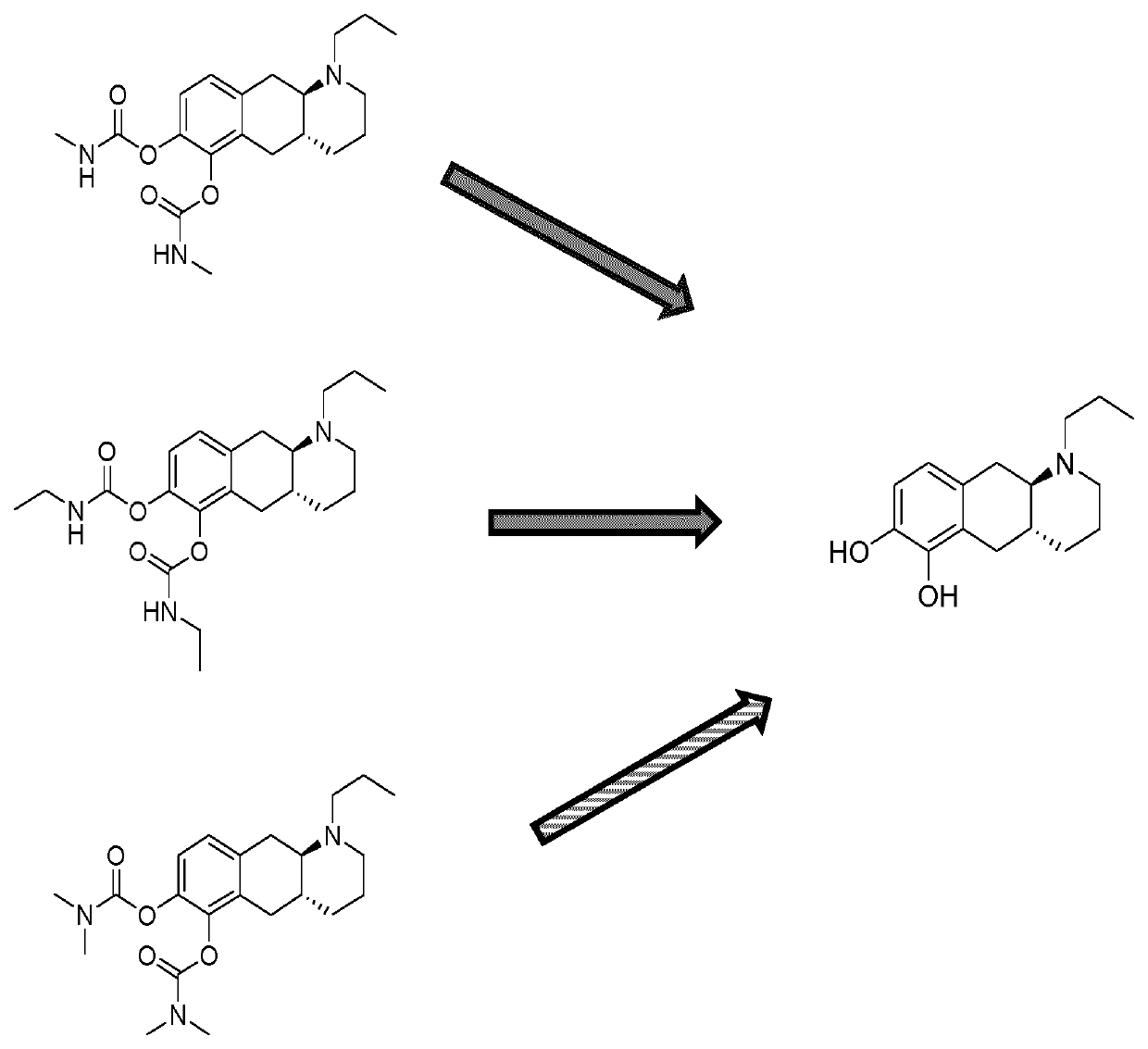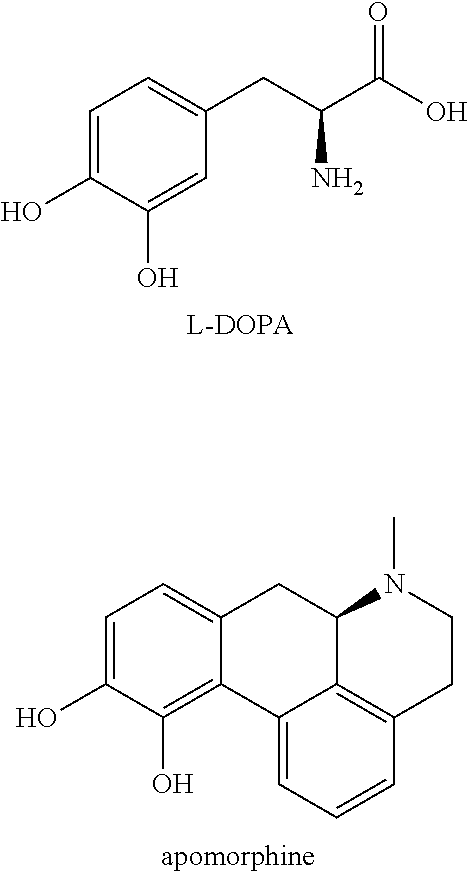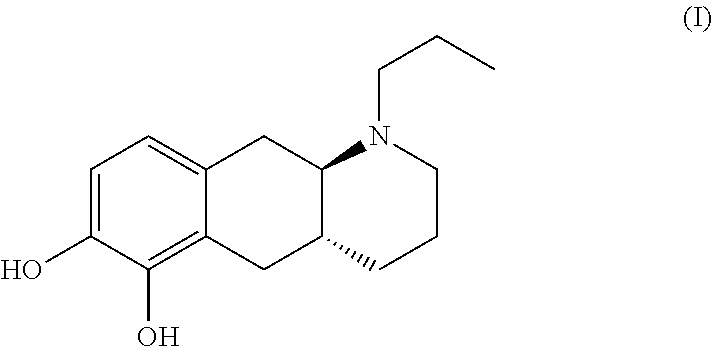Catecholamine carbamate prodrugs for use in the treatment of parkinson's disease
a technology of catecholamine carbamate and prodrug, which is applied in the field of catecholamine carbamate prodrug for use in the treatment of parkinson's disease, can solve the problems of poor pharmacokinetic profile, inability to predict the conversion to the parent compound in humans, and inability to achieve clinical use, etc., to improve the minimal brain dysfunction (mbd), improve the effect of dopaminergic turnover and positive
- Summary
- Abstract
- Description
- Claims
- Application Information
AI Technical Summary
Benefits of technology
Problems solved by technology
Method used
Image
Examples
example 1
n of Compounds of the Invention in Human Plasma
[0449]Frozen human plasma was thawed and then centrifuged at 3200×g for 5 minutes to remove debris. The pH value of the supernatant was then measured and adjusted to 7.4±0.1 by adding 1% phosphoric acid or 1 N sodium hydroxide. 2 μL of dosing solution (50 μM for test compounds and 100 μM for positive control (propantheline bromide)) was mixed with 98 μL of blank plasma to achieve 1 μM test compound and 2 μM positive control of final concentration. The mixture was incubated, and samples were withdrawn from the incubations at the pre-determined time points of 0, 0.5, 1, 2, 4 and 6 hours (in duplicate) at 37° C. in water bath. At each corresponding time point 10 μL inhibitor and 20 μL ascorbic acid and 2 μL formic acid (20%) are added, and then added 400 μL of “stop solution” (200 ng / mL tolbutamide plus 200 ng / mL labetalol in 50% ACN / MeOH) to precipitate protein. The substance was mixed thoroughly and thereafter Centrifugated at 4,000 rpm ...
example 2
onist Activity and Binding Assay
[0451]Evaluation of the agonist activity of compounds (I), (Ia) and (Ib) at the human 5-HT2B receptor was performed by Eurofins / Cerep (France) measuring the compound effects on inositol monophosphate (IP1) production using the HTRF detection method. Briefly, the human 5-HT2B receptor was expressed in transfected CHO cells. The cells were suspended in a buffer containing 10 mM Hepes / NaOH (pH 7.4), 4.2 mM KCl, 146 mM NaCl, 1 mM CaCl2, 0.5 mM MgCl2, 5.5 mM glucose and 50 mM LiCl, then distributed in microplates at a density of 4100 cells / well and incubated for 30 min at 37° C. in the presence of buffer (basal control), test compound or reference agonist. For stimulated control measurement, separate assay wells contained 1 μM 5-HT. Following incubation, the cells were lysed and the fluorescence acceptor (fluorophen D2-labeled IP1) and fluorescence donor (anti-IP1 antibody labeled with europium cryptate) were added. After 60 mi...
example 3
ments in Rats
[0453]For all the experiments, blood samples of approximately 0.68 mL were drawn from the tail or sublingual vein and put into K3EDTA tubes that had been pre-cooled and prepared with stabilizing solution consisting of 80 μL ascorbic acid and 40 μL 100 mM D-saccharic acid 1,4 lactone in water. The tubes were inverted gently 6-8 times to ensure thorough mixing and then placed in wet ice. The collecting tube was placed in wet ice for up to 30 minutes until centrifugation. Once removed from the wet ice the centrifugation was initiated immediately. Immediately after end of centrifugation the samples were returned to wet ice. Three sub-samples of 130 μL plasma were transferred to each of three appropriately labelled cryo tubes containing 6.5 μL pre-cooled formic acid (20%) (the tubes were pre-spiked and stored refrigerated prior to use). The tube lid was immediately replaced, and the plasma solution was thoroughly mixed by inverting gently 6-8 times. The samples were stored f...
PUM
| Property | Measurement | Unit |
|---|---|---|
| temperature | aaaaa | aaaaa |
| temperature | aaaaa | aaaaa |
| temperature | aaaaa | aaaaa |
Abstract
Description
Claims
Application Information
 Login to View More
Login to View More - R&D
- Intellectual Property
- Life Sciences
- Materials
- Tech Scout
- Unparalleled Data Quality
- Higher Quality Content
- 60% Fewer Hallucinations
Browse by: Latest US Patents, China's latest patents, Technical Efficacy Thesaurus, Application Domain, Technology Topic, Popular Technical Reports.
© 2025 PatSnap. All rights reserved.Legal|Privacy policy|Modern Slavery Act Transparency Statement|Sitemap|About US| Contact US: help@patsnap.com



